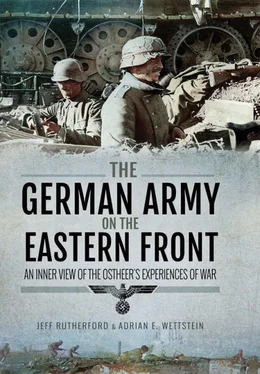Whatever gaps existed between German and Soviet weapons, German armaments could only be effective if they were operational. The climate conditions in Russia, the lack of maintenance due to the demands on the troops, and the lack of training, as well as the unexpected duration of service for German weapons, wore many of them out. Only a constant flow of replacement weapons and spare parts could fill this gap. But this was not the case and the capability to repair weapons simply did not exist, as the report shows:
On the question of spare parts indicated above – which was already addressed in an interim report, must be pointed out again. A really frightening lack of spare parts exists everywhere with all infantry weapons and the artillery. One agency literally reported: One would rather receive a complete gun than some spare parts.
For this reason, numerous guns of all kinds, infantry guns, ATGs and machine guns, as well as bicycles, have already fallen out by now and are continuing to fall out. Since scarcely any spare parts were in supply – there are unsatisfied demands for spare parts of 6 months and more – the troops cannibalize their weapons, i.e. they make 2 machine guns out 4 defective ones. The rest is carried along for a while at best and is then lost piece by piece. Why such a lack of spare parts exists is difficult to say. Either this crisis is not sufficiently known, or the ‘Führer’s demands’, which refer only to new weapons, do not permit the production of spare parts to a sufficient extent, or the allocation of raw materials is inadequate.
Last year, a huge campaign ‘Panzer spare parts’ went through the bureau. A similar campaign ‘weapon spare parts’ must be launched. With a fraction of the capacity required to produce new weapons, the same quantity of weapons could be restored by providing spare parts, thus restoring their readiness.
The same shortage exists for all kinds of tools. If one were to help the field workshops and armourer platoons one-time in this respect, many defective weapons could be restored, which the troops are not now in the position due to the current tool situation […]
[…] New enemy weapons, tanks, guns and munitions are not to be expected for the time being. In addition to the T 34, particularly the heavy mortar and the so-called ‘ Stalinorgel ’ [the German nickname for the Katyusha] have moral effects.
[…] Assault guns are still demanded in as large a quantity as possible. A corps-commanding general remarked that assault guns and planes with machine guns and machine cannons had helped him most in attack. This is understandable inasmuch as we have for some time apparently held absolute air-superiority. In one section, 92 Russian airplanes were shot down in a single day without a single loss of our own.
[…] The troops are aware that German industry is fully occupied and that the same lack of manpower dominates at home as at the front. Nevertheless, the soldier expects that his most urgent demands will be fulfilled – here the heavy mortar will come first – because the lack of suitable weapons costs his blood.
The call for assault guns was heavily driven by the anti-tank capacity of those vehicles, especially as the new long-barrelled version arrived at the front in spring 1942. [12]As with the heavy mortar, German industry never satisfied the frontline demands for this weapon. While this was due in part to industrial capacity, it was also a result of the artillery branch not being a priority (the assault gun was part of the artillery branch) for the High Command, which preferred offensive weapons such as tanks, and this preference continued even after Germany was definitively on the defensive. But even inside the artillery branch, the heaviest guns were preferred over the assault gun. [13]The lack of assault guns and later tank destroyers substantially decreased the defensive capabilities of German infantry units, as they lacked mobile anti-tank weapons with heavy firepower.
While some areas of German weaponry underwent major developments, other areas only experienced minor changes. Though already outdated by the beginning of Operation Barbarossa, Mark I and II tanks still constituted 28 per cent of the armour in the invasion. By summer 1944, the long-barrelled Mark IV was the main combat tank, but Panthers and Tigers had become available in larger numbers. And while assault guns and self-propelled ATGs were rather the exception in summer 1941, they surpassed the numbers of tanks in 1944. ATGs had risen in calibre from 3.7cm to 12.8cm, in weight from 435kg to over 10,000kg, thereby completely transforming the tactical idea of the ATG. In 1941, infantry units had oversized rifles of questionable value for anti-tank defence. In 1944, German infantry units could field the Panzerschreck , an improved copy of the US Bazooka, and the Panzerfaust , a cheap one-man single-use weapon. Both were highly effective against tanks, but were also valuable in other arenas as well, including urban warfare.
The changes were much smaller where artillery or infantry weapons were concerned. In fact, except for anti-tank weapons, few things changed for the ordinary infantry division between summer 1941 and 1944. Most notably, divisional artillery remained the same, with the exception of organically attached rocket launchers in a few divisions. The same was the case with infantry weapons. All attempts to replace the outdated rifle 98k failed due to a mixture of excessive demands on a new weapon, military conservatism, and finally, of course, a lack of production capability. The widespread use of a technically reliable individual weapon with more firepower, such as the semi-automatic rifle G43 or the revolutionary Assault Rifle 44, earlier in the war, would have had a strong tactical effect, but it failed to occur. The technology and structure of German heavy infantry weapons also experienced only minor changes. In contrast to the individual weapons, the machine gun 42 should have completely replaced the machine gun 34, but this never fully happened. Even worse, many newly formed units, as well as many rear area units, had to rely on captured machine guns or on old German First World War models such as the MG 08/15. While the light 5cm mortar was put out of service in 1942, generally replaced by the rifle grenade, the fire support combination of medium mortars and light and heavy infantry guns was never called into question. This combination allowed for a broad ability to respond to various tactical issues, but it also resulted in a lower production output as various weapons were produced instead of concentrating on one model, and it required differently trained crews and leaders to be able to use the combination effectively. Experiences with the Soviet-copied 12cm mortar offered an alternative that, however, was never seriously considered.
The introduction of new weapons under war-time conditions is a task often underestimated, as the following two sources indicate. Even when only parts of a weapons system were replaced, this proved problematic, as the following report from 1942 on the first use of heavy infantry guns on assault gun chassis – both proven systems – shows: [14]
The following deficiencies were found after arrival of the assault guns with heavy infantry guns, with six of each sent to the Assault Gun Battalions 177 and 244:
1) Assault Gun Battalion 177
A) Guns
Old assault gun chassis with significant technical deficiencies which must be repaired before deployment: typical deterioration due to age of the chassis and engine (steering brakes, carburettor, fuel pump, track roller, tracks, etc.). No observation equipment for gun commander (the battery commander’s telescope must be installed in a makeshift position). No ballistic tables and operating instructions available.
Читать дальше






![John Stieber - Against the Odds - Survival on the Russian Front 1944-1945 [2nd Edition]](/books/405234/john-stieber-against-the-odds-survival-on-the-russian-front-1944-1945-2nd-edition-thumb.webp)





